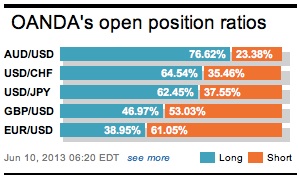In months gone by there would be a respite after NFP – the market gave investors time to lick their wounds and devise a trading strategy during the first session following the employment headline release. Historically, the Monday after NFP used to be the “least” volatile trading day-of-the-month. Asia it seems is now determined to break with routine. Disappointing Chinese weekend data has not given any asset classes a breather across the divide. Market price movement has managed not to skip a beat from last week’s action – determined to keep up momentum. However, with the lack of North American fundamental data today, it will be near impossible to keep to the same rhythm.

May data for China points to a further slowdown in their economic growth – an issue that the fragile global economy cannot sustain in the short-term. Over the weekend, the world’s second-largest economy’s exports growth slowed to +1.0%, y/y, below consensus forecasts and in “sharp moderation from the average of +17.3% print for the first-third of the year (some dubious “over-invoicing” of export questions remain in the previous reporting). Imports contracted -0.3%, y/y, versus a market expectation for growth of +6.6%.
Data like this has some analysts questioning Q2 GDP growth – some early revisions have it slowing to +7.5% from +7.7% following the collapse in exports and import growth. Combine with a deceleration in industrial production; an underwhelming rise in retail sales, thrown in an absence of inflationary pressure and the possibility of an interest rate cut by the PBoC is a distinct concern. The plausibility has still to gain some market traction. The Chinese Premier, Li Keqiang, has been telling his provincial leaders “that while growth is still relatively fast” and within a reasonable range and employment is stable, there are “complicated factors” ahead and must be closely monitored.
The correlation between the world’s current two most crowded trades – USD/JPY and the Nikkei remains intact (short Yen and long the Tokyo bourse is surviving). The overnight sharp rise in Japanese equities (+3.2%) was supported mostly by positive employment data from the US and a higher than expected current account surplus from Japan (+¥750-billion vs. +¥310-billion). Last night, Japanese equities had the largest one-day gain in two-years – helping to erase some of the heavy session declines this market has born witness to in the past fortnight. The last three-weeks has delivered a strong increase in Japanese repatriation flows following the short respite around the Golden Week period, driven mostly by banks in April and May, while lifers also returned to repatriation in May after accumulating foreign assets in April.

USD/JPY is threatening to spoil the speculators day again. Heading in to NFP last week the market witnessed the Yen short positions significantly been reduced. On the flip side, there were a percentage of investors who were inclined to buy dollar-dips until late Thursday and spoil the spec’s directional flow. This initial selloff led to some significant market dollar-longs, yen-shorts heading into the US employment release. Ever since the release, it seems that top picking has become a speculators priority, the same individuals who happened to cover a good percentage of their Yen shorts. The current market squeeze is now stretching expectations post-NFP and making it more expensive for the speculator to reestablish their short Yen positions.

Perceptions are everything. Chancellor Merkel still manages to maintain her ‘aura of authority’ despite her domestic election concerns. She insists that the Euro-nations must follow Germany’s lead in tightening budgets and reshaping the labor markets to return to growth. The Chancellor is obviously “to stave off any crisis eruptions” ahead of the German elections in September. The 17-member states must stick to a recipe of budget discipline and improving competitiveness so that growth can take hold. Her comments have done little for the EUR – market movement has been put on hold with trade confined to a tight range as investors concentrate on Asian Pacific currencies. The speculators that were forced out of their positions last week are probably looking to reestablish these “pos” by buying EUR dips. In truth, Draghi has failed to feed the EUR bear with a strong enough dovish line and NFP has yet to ignite the dollar- leading to what? A EUR win by default as emerging markets unwind? Just look at EUR/AUD – it has appreciated +15% since April!

Other Links:
Canada Bests US Jobs by a Country Mile
Dean Popplewell, Director of Currency Analysis and Research @ OANDA MarketPulseFX
This article is for general information purposes only. It is not investment advice or a solution to buy or sell securities. Opinions are the authors; not necessarily that of OANDA Corporation or any of its affiliates, subsidiaries, officers or directors. Leveraged trading is high risk and not suitable for all. You could lose all of your deposited funds.



